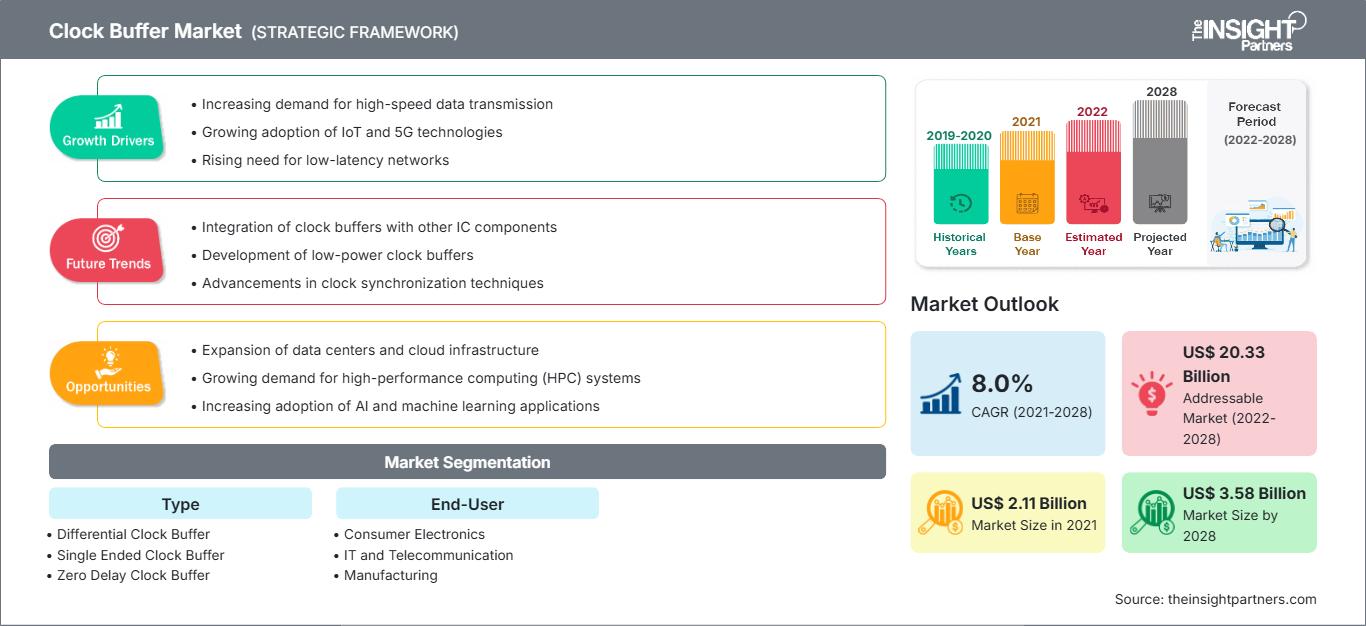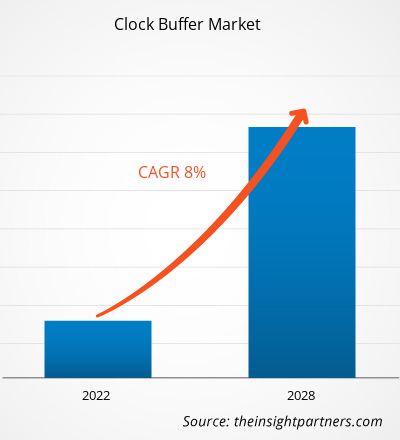Si prevede che il mercato dei buffer di clock raggiungerà i 3.579,91 milioni di dollari entro il 2028, rispetto ai 2.112,53 milioni di dollari del 2021; si prevede una crescita a un CAGR dell'8,0% dal 2022 al 2028.
Il mercato globale dei buffer di clock, in base all'area geografica, è segmentato in Nord America, Europa, Asia-Pacifico, Medio Oriente e Africa e Sud America. Nel 2021, il Nord America ha guidato l'analisi del mercato dei buffer di clock con una quota del 40,5%, seguito da Asia-Pacifico ed Europa. Negli ultimi anni, la domanda di cloud computing ha registrato una crescita significativa, che ha accelerato la penetrazione di Internet. Pertanto, molti IDE stanno investendo ingenti capitali in Nord America, il che ha un impatto positivo sul cloud computing. Il governo degli Stati Uniti ha adottato numerose iniziative per promuovere il settore dell'elettronica di consumo. Ad esempio, il 6 maggio 2022, il governo degli Stati Uniti ha proposto una nuova proposta bipartisan per alimentare il settore dei circuiti stampati (PCB) del Paese. Molte aziende affermate nel settore della produzione di elettronica negli Stati Uniti hanno accolto con favore la proposta. Il disegno di legge supporterà il CHIPS Act del 2021 e l'American Printed Circuit Boards Act del 2022. Di conseguenza, i principali operatori del mercato nordamericano dei buffer di clock potrebbero beneficiare di opportunità redditizie nei prossimi anni. Il mercato dei buffer di clock nell'area Asia-Pacifico è segmentato in India, Cina, Giappone, Australia e il resto dell'area Asia-Pacifico. Molti governi della regione sono stati costretti a rivedere i loro approcci all'acquisto di dispositivi aggiornati, come desktop, laptop e personal computer, e apparecchiature server generiche da fornitori e produttori designati a causa della crisi COVID-19. Pertanto, la domanda di altri sistemi di comunicazione, come router, modem, sistemi elettronici cablati e wireless (pannelli) e altre periferiche, è in aumento, il che ha creato numerose opportunità redditizie per i principali fornitori che operano nel mercato dei buffer di clock. In India, i fornitori di servizi e soluzioni di informazione, comunicazione e tecnologia hanno spostato i loro modelli di business verso il lavoro da remoto a causa dell'inizio della crisi COVID-19. Inoltre, scuole e università hanno continuato a operare da remoto nel 2022, rendendo fondamentale la necessità di un dispositivo informatico per gli studenti. Alcuni studenti che in precedenza utilizzavano smartphone/tablet per le lezioni virtuali sono passati ai PC, poiché offrono vantaggi come schermi più grandi e facilità d'uso, con un impatto positivo sul mercato dei buffer di clock.
Personalizza questo rapporto in base alle tue esigenze
Potrai personalizzare gratuitamente qualsiasi rapporto, comprese parti di questo rapporto, o analisi a livello di paese, pacchetto dati Excel, oltre a usufruire di grandi offerte e sconti per start-up e università
Mercato dei buffer di clock: Approfondimenti strategici

-
Ottieni le principali tendenze chiave del mercato di questo rapporto.Questo campione GRATUITO includerà l'analisi dei dati, che vanno dalle tendenze di mercato alle stime e alle previsioni.
Impatto della pandemia di COVID-19 sul mercato dei Clock Buffer
Grazie alle politiche governative favorevoli volte a promuovere l'innovazione e rafforzare le capacità infrastrutturali, il Nord America vanta il più alto tasso di accettazione e sviluppo delle tecnologie emergenti. Secondo il North American Data Center Trends Report 2020 di CBRE, il settore dei data center della regione è stato forte nella prima metà del 2020 grazie all'implementazione di infrastrutture IT ibride da parte delle organizzazioni per sviluppare capacità di lavoro da remoto. La pandemia di COVID-19 in Nord America ha costretto le aziende a implementare una strategia di lavoro da casa (WFH) per proseguire i processi aziendali durante la crisi, il che ha rafforzato la domanda di big data e analisi dei dati. Nel 2020, le aziende hanno esplorato applicazioni di intelligenza artificiale e analisi dei big data per fornire agli utenti informazioni utili per pianificare l'utilizzo delle risorse per specifiche sfide in ambito medico e hanno proposto un modello sanitario basato sull'intelligenza artificiale e sull'analisi dei big data. Tuttavia, a partire dal primo trimestre del 2021, le linee di fornitura dell'industria automobilistica ed elettronica hanno iniziato a stabilizzarsi e i ricavi di questi settori hanno mostrato uno slancio positivo, che ha successivamente spinto la crescita del mercato dei buffer di clock in Nord America.
Approfondimenti di mercato - Mercato dei buffer di clock
Il mercato dei buffer di clock in Europa è segmentato in Francia, Germania, Russia, Regno Unito e resto d'Europa. L'emergere di elettrodomestici intelligenti, come lavatrici, condizionatori d'aria, telecamere di sicurezza e forni a microonde, sta ulteriormente contribuendo alla crescita del mercato dei buffer di clock. I consumatori in Europa hanno migliorato il loro tenore di vita. Inoltre, la crescente diffusione di Wi-Fi e Bluetooth ha portato all'acquisto di elettrodomestici. Pertanto, la domanda di dispositivi intelligenti è elevata. Il termostato Google Nest, l'ultimo elettrodomestico intelligente, utilizza un'app per smartphone che controlla il sistema HVAC e, quando un utente si avvicina, il dispositivo si attiva e il display. La domanda di buffer di clock aumenterà con la crescita dell'elettronica di consumo.
Approfondimenti basati sulla tipologia
In base alla tipologia, il mercato dei buffer di clock è segmentato in buffer di clock differenziale, buffer di clock a zero e buffer di clock single-ended. I buffer di uscita single-ended possono avere ingressi single-ended o differenziali. I buffer di clock di uscita single-ended sono LVCMOS, mentre i buffer di uscita differenziali possono essere LVPECL, HSTL o Low Voltage Differential Signaling (LVDS).
Il mercato è segmentato in base alla tipologia, all'utente finale e all'area geografica. In base alla tipologia, il mercato è segmentato in buffer di clock differenziale, buffer di clock a zero e buffer di clock single-ended. In base all'utente finale, il mercato è segmentato in elettronica di consumo, IT e telecomunicazioni, produzione, automotive, medicina e assistenza sanitaria, settore militare e difesa. In base all'area geografica, il mercato è segmentato in Nord America, Europa, Asia Pacifico (APAC), Medio Oriente e Africa. Africa (MEA) e America Centrale e Meridionale.
Renesas Electronics Corporation, Texas Instruments, Infineon Technologies AG, Analog Devices e Texas Instruments sono alcuni dei protagonisti profilati durante lo studio del mercato dei buffer di clock.
Mercato del buffer di clockLe tendenze regionali e i fattori che influenzano il mercato dei Clock Buffer durante il periodo di previsione sono stati ampiamente spiegati dagli analisti di The Insight Partners. Questa sezione illustra anche i segmenti e la geografia del mercato dei Clock Buffer in Nord America, Europa, Asia-Pacifico, Medio Oriente e Africa, America Meridionale e Centrale.
Ambito del rapporto di mercato sui buffer di clock
| Attributo del rapporto | Dettagli |
|---|---|
| Dimensioni del mercato in 2021 | US$ 2.11 Billion |
| Dimensioni del mercato per 2028 | US$ 3.58 Billion |
| CAGR globale (2021 - 2028) | 8.0% |
| Dati storici | 2019-2020 |
| Periodo di previsione | 2022-2028 |
| Segmenti coperti |
By Tipo
|
| Regioni e paesi coperti |
Nord America
|
| Leader di mercato e profili aziendali chiave |
|
Densità degli attori del mercato del buffer di clock: comprendere il suo impatto sulle dinamiche aziendali
Il mercato dei Clock Buffer è in rapida crescita, trainato dalla crescente domanda degli utenti finali, dovuta a fattori quali l'evoluzione delle preferenze dei consumatori, i progressi tecnologici e una maggiore consapevolezza dei vantaggi del prodotto. Con l'aumento della domanda, le aziende stanno ampliando la propria offerta, innovando per soddisfare le esigenze dei consumatori e sfruttando le tendenze emergenti, alimentando ulteriormente la crescita del mercato.

- Ottieni il Mercato dei buffer di clock Panoramica dei principali attori chiave
Gli operatori del mercato dei buffer di clock si concentrano principalmente sullo sviluppo di prodotti avanzati ed efficienti.
- Nel 2021, Skyworks Solutions, Inc. ha stipulato un accordo definitivo con Silicon Laboratories Inc. per un mondo intelligente e connesso, in base al quale Skyworks acquisirà le attività infrastrutturali e automotive di Silicon Labs in una transazione interamente in contanti del valore di 2,75 miliardi di dollari.
- Nel 2022, Renesas Electronics Corporation ha introdotto i primi buffer di clock e multiplexer conformi alle rigorose specifiche PCIe Gen6. I nuovi dispositivi si uniscono ai generatori di clock a basso jitter 9SQ440, 9FGV1002 e 9FGV1006 di Renesas per fornire ai clienti una soluzione di timing PCIe Gen6 completa per data center/cloud computing, networking e applicazioni industriali ad alta velocità.
- Analisi storica (2 anni), anno base, previsione (7 anni) con CAGR
- Analisi PEST e SWOT
- Valore/volume delle dimensioni del mercato - Globale, Regionale, Nazionale
- Industria e panorama competitivo
- Set di dati Excel
Report recenti
Testimonianze
Motivo dell'acquisto
- Processo decisionale informato
- Comprensione delle dinamiche di mercato
- Analisi competitiva
- Analisi dei clienti
- Previsioni di mercato
- Mitigazione del rischio
- Pianificazione strategica
- Giustificazione degli investimenti
- Identificazione dei mercati emergenti
- Miglioramento delle strategie di marketing
- Aumento dell'efficienza operativa
- Allineamento alle tendenze normative






















 Ottieni un campione gratuito per - Mercato dei buffer di clock
Ottieni un campione gratuito per - Mercato dei buffer di clock